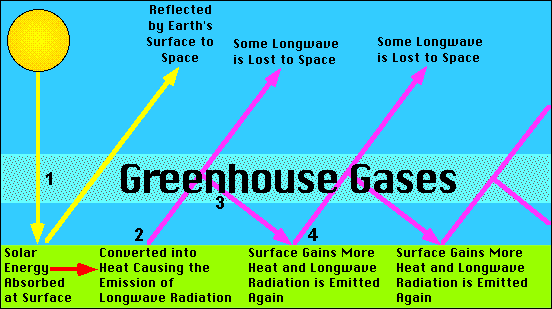THE NATURAL ENVIRONMENT
Geography 101
ToC
HEAT
Albedo
Greenhouse
Balance
Global
Local
Greenhouse Warming
|
|
BOX 1 |
As noted earlier, all surfaces emit electromagnetic (em) radiation. Hotter objects emit more energy and at shorter wavelenghts than cooler objects. While the sun is hot enough to radiate in visible wavelengths, the much-cooler Earth radiates mostly in middle and far infrared (4 to 1000 micrometers) wavelength bands that we cannot see. We call these wavelengths longwave, or terrestrial, radiation. It is critically important to distinguish between solar, shortwave radiation emitted by the Sun and terrestrial, longwave radiation emitted by the Earth.
While we normally cannot see terrestrial radiation, we occasionally can if the surface is hot enough. You can see lava glowing, for example. That's because it is hot enough to emit some red light. As it cools, the glow fades and disappears as the lava emits longer and longer wavelengths. Just because you can no longer see the red color does not mean that the lava has stopped radiating, however; it continues to radiate at wavelengths your eye cannot detect.
It turns out that atmospheric gases absorb longwave radiation very strongly. This causes a warming of planetary surfaces by a process we call the greenhouse effect. The greenhouse effect is said to "trap heat" making the planet's surface warmer than it would be without a greenhouse effect. The process has four basic steps:
- sunlight is NOT strongly absorbed by the atmosphere and passes through to heat the surface
- the surface warms and emits longwave radiation upward
- the atmosphere absorbs most longwave radiation and re-radiates some toward the surface
- the atmospheric longwave radiation warms the surface and the cycle repeats
The diagram below illustrates the process. In the diagram, yellow arrows refer to solar (shortwave) radiation and pink arrows refer to terrestrial (longwave) radiation.

Overall, Earth's greenhouse effect causes the surface temperature to increase by about 35° C (63° F). The main greenhouse gas is water vapor, as shown in the Greenhouse Warming table. This level of surface warming is extremely important because, without it, life would have had difficulty developing. One need only to compare with our neighboring planets to see why this is true, as shown in the Comparison of Planetary Greenhouse Effects table below.
Greenhouse Warming
|
||
|
Water |
22°C |
|
 Notice
that Venus is far hotter than Earth, even though it
absorbs less sunlight (650 W/m2 compared to 930 W/m2) due to its high planetary albedo. Venus' thick carbon dioxide
atmosphere produces a greenhouse effect of over 500° C, giving it
a scorching 462° C surface temperature.
Notice
that Venus is far hotter than Earth, even though it
absorbs less sunlight (650 W/m2 compared to 930 W/m2) due to its high planetary albedo. Venus' thick carbon dioxide
atmosphere produces a greenhouse effect of over 500° C, giving it
a scorching 462° C surface temperature.
 Earth
on the other hand, has a far smaller atmosphere (see atmospheric pressure
column) and a modest greenhouse warming of only 35° C. This mild
warming is extremely important, however, because without it, the surface
would
average a frozen -20° C, making the profusion
of life we see today unlikely.
Earth
on the other hand, has a far smaller atmosphere (see atmospheric pressure
column) and a modest greenhouse warming of only 35° C. This mild
warming is extremely important, however, because without it, the surface
would
average a frozen -20° C, making the profusion
of life we see today unlikely.
 Mars
occupies the other extreme. With only a tiny 6° C greenhouse effect,
Mars remains a frozen planet averaging -55° C. Venus is too hot, Mars is
too cold,
and Earth is just right for living things. This fact has not escaped
scientists, some of who subscribe to the Gaia Hypothesis,
which suggests that life on Earth, collectively, influenced and co-evolved with the environment through feedback loops to produce equilibrium conditions. Indeed, since life has emerged
on land over the past 500 million years, among other things, the surface
temperature has been remarkably stable, the oxygen level surprisingly
constant, and the oceanic salinity amazingly uniform.
Mars
occupies the other extreme. With only a tiny 6° C greenhouse effect,
Mars remains a frozen planet averaging -55° C. Venus is too hot, Mars is
too cold,
and Earth is just right for living things. This fact has not escaped
scientists, some of who subscribe to the Gaia Hypothesis,
which suggests that life on Earth, collectively, influenced and co-evolved with the environment through feedback loops to produce equilibrium conditions. Indeed, since life has emerged
on land over the past 500 million years, among other things, the surface
temperature has been remarkably stable, the oxygen level surprisingly
constant, and the oceanic salinity amazingly uniform.
Comparison of Planetary Greenhouse Effects |
|||||||||
| distance from sun | sunlight intensity | albedo | absorbed sunlight | surface pressure | greenhouse gases | temperature with no greenhouse | greenhouse warming | actual temper-ature | |
|
AU |
W/m2 |
% |
W/m2 |
mb |
|
°C |
°C |
°C |
|
| Venus |
0.723 |
2620 |
75 |
650 |
92000 |
CO2 |
-42 |
504 |
462 |
| Earth |
1.00 |
1370 |
32 |
930 |
1013 |
H2O, CO2 |
-20 |
35 |
15 |
| Mars |
1.52 |
590 |
22 |
460 |
7 |
CO2 |
-61 |
6 |
-55 |
| Titan |
9.54 |
15 |
30 |
11 |
1500 |
N2, CH4 |
-191 |
12 |
-179 |
While the overall effect of greenhouse warming has been beneficial to life on Earth, anthropogenic (human-introduced) gases, especially carbon dioxide and methane, are causing an enhanced greenhouse effect. In other words, human industry is causing greenhouse warming to increase from 35° C to 36° C, 37° C, 38° C or more. This warming is expected to cause major changes in the global environment such as shifts in weather patterns, climate zones, ecological ranges, storm intensity, and rising sea levels as the Greenland and Antarctic Ice Caps partially melt and shrink.
